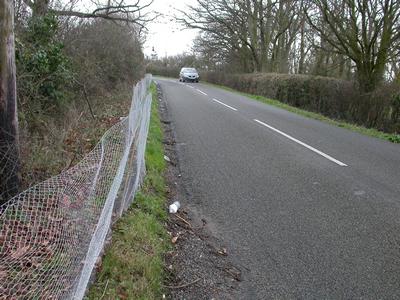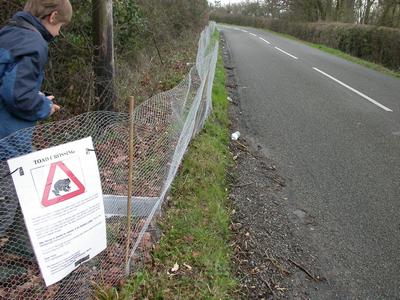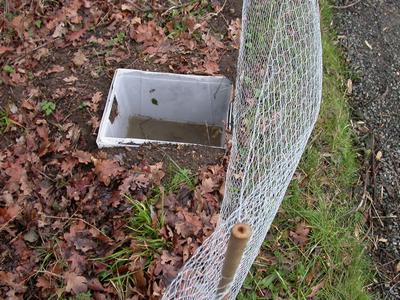 |
 |
 |
| Marybrook Farm Toad fence © Harry Green |
Worcestershire Record No. 24 April 2008 pp. 13-14
Harry Green
 |
 |
 |
| Marybrook Farm Toad fence © Harry Green |
This year in Worcestershire a new method has been used at two sites. Jurjen Annen, Wetland Officer at the Worcestershire Wildlife Trust, comes from the Netherlands and he has led the way and shown a method used in his home country. Early in Spring a fine-meshed wire netting fence (approximately one metre high with 1-1.5 cm holes) is erected at the roadside (obviously the side where the toads start to cross the road) and held in place by bamboo canes or similar. The base of the fence is bent in an L-shape (base pointing towards the toad approach route) and covered with soil. Every 10 metres of so along the fence a rectangular plastic container (36x26x24 (deep) cm) is placed in a hole dug in the ground (obviously on the side away from the road) with the rim flush with the soil surface. The fence is as long as the known width of the toad-crossing – perhaps 100 metres. Readers will now have worked out what happens! Toads come purposefully towards the road, turn aside when they reach the fence and move along in until – plop – they drop into the plastic container! There they stay until the person operating the system arrives at dawn to collect them in a bucket, carry them across the road and let them go to continue their journey. The method is more effective at catching toads than dashing about in the traffic with a bucket, and safer for both people and toads.
This system was tried on the Pershore to Little Comberton road near Marybrook Farm and near the Ravenshill Reserve at Alfrick, and proved to be highly effective. The numbers caught each day are shown in the tables. In summary a total of 955 toads were carried across the roads. Quite often pairs were in amplexus with small males clutching to the backs of the large females carrying them across the countryside. Once eggs are laid and the males have discharged sperm they break from amplexus.
There is a catch. We have discovered than once the egg laying is done the toads are on the move again. They spend very little time in the pond and soon trek out into the countryside. Some at least seem to follow the same route back to summer and hibernating quarters as they used on the inward journey. This of course leads them back to crossing places on roads. Once this movement starts the catching fence must be removed of course otherwise the toads find their way forward blocked and wander along on the traffic side of the fence. Also of course they have crossed the road and may get squashed on the way. At Ravenshill 63 were found dead on the road on the night they started the return journey.
This introduces an interesting project – as soon as movement to the pond ceases the fence can be transferred to the other side of the road to catch toads on the return journey. This will of course save toads from being squashed by traffic. Additionally making studies of this type and counting all the toads caught will give interesting information on the numbers of toads using a road crossing.
In the future the hope is that people living near to toad crossings can be encouraged to run a fencing system so saving the lives of many toads.
Comments on tables:
| At both sites toad movements had started before the fences were erected. | |
| Interestingly peak movement between 14th-16th March occurred at both
sites. Similarly toads were on return journeys at both sites by 1st April. |
Near Marybrook Farm |
Ravenshill Wood |
|||||||
| SO956441 | SO741539 | |||||||
| Date | Time | Male | Female | Total | Comments | DATE | TOADS MOVED | |
| 24/02/2008 | 8.3 | 16 | 16 | 23/02/2008 | fence erected | |||
| 24/02/2008 | 18 | 5 | 5 | 24/02/2008 | frost | |||
| 25/02/2008 | 8 | 1 | 1 | 25/02/2008 | 21 | |||
| 26/02/2008 | 8.3 | 58 | 58 | 2 newts, 1 frog | 26/02/2008 | 3 | ||
| 01/03/2008 | 8 | 12 | 0 | 12 | 29/02/2008 | 21 | ||
| 02/03/2008 | 8.3 | 2 | 1 | 3 | 01/03/2008 | 12 | ||
| 03/03/2008 | 8 | 1 | 1 | 07/03/2008 | 12 | |||
| 03/03/2008 | 18 | 1 | 1 | 09/03/2008 | 12 | |||
| 09/03/2008 | 8 | 31 | 3 | 34 | 10/03/2008 | 12 | ||
| 10/03/2008 | 8 | 1 | 1 | 12/03/2008 | 5 | |||
| 13/03/2008 | 8 | 2 | 2 | 14/03/2008 | 90 | |||
| 14/03/2008 | 8 | 8 | 2 | 10 | 15/03/2008 | 186 | ||
| 15/03/2008 | 8 | 50 | 7 | 57 | 16/03/2008 | 3 | ||
| 16/03/2008 | 8 | 76 | 39 | 115 | 20/03/2008 | 111 | ||
| 17/03/2008 | 8 | 5 | 1 | 6 | 25/03/2008 | 11 | ||
| 18/03/2008 | 8 | 1 | 1 | 27/03/2008 | 23 | |||
| 20/03/2008 | 8 | 9 | 3 | 12 | 28/03/2008 | 10 | ||
| 21/03/2008 | 8 | 0 | 29/03/2008 | 61 | ||||
| 22/03/2008 | 8 | 0 | ||||||
| 23/03/2008 | 8 | 0 | TOTAL | 593 | ||||
| 24/03/2008 | 8 | 1 | 1 | |||||
| 25/03/2008 | 8 | 2 | 2 | |||||
| 26/03/2008 | 8 | 1 | 1 | |||||
| 27/03/2008 | 8 | 1 | 1 | |||||
| 28/03/2008 | 8 | 4 | 4 | |||||
| 29/03/2008 | 8 | 7 | 3 | 11 | ||||
| 31/03/2008 | 8 | 3 | 1 | 4 | ||||
| 01/04/2008 | 8 | 2 | 1 | 3 | Signs of toads returning across road, crossing removed | |||
| TOTAL | 284 | 58 | 362 | |||||
| Sex of toads may be
inaccurate as it was only recorded when females were either paired with
males (in amplexus)or obviously female due to large size. Small or young
females may have been identified as males.
Dates relate to the morning of collection. |
Morning of 30th we counted 63 toads dead in the road. A lot of these were in front of the fence, indicating they were on the way back to the wood. | |||||||
| WBRC Home | Worcs Record Listing by Issue | Worcs Record Listing by Subject |